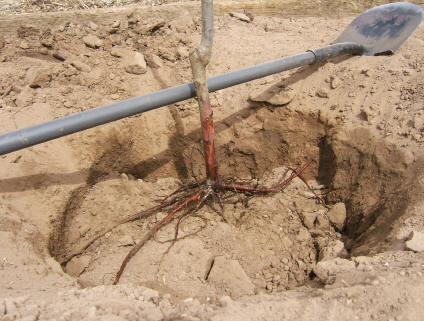
(4/8) Over the years, I have been asked questions like "what does bare root mean?" or "when’s the best time to plant a B & B tree?", or "is it better to plant something big or small?" Hopefully within the next few paragraphs, those questions will be answered.
"Bare root", "B & B", "Container" – all of these words share a common factor. These terms all relate to how plants are sold.
Bare root plants are sold without any soil on the root system and before the plant starts to come into leaf or flower. Perennials, shrubs and trees can all be purchased this way. Of course, certain species react better than others when managed as a bare root plant. Most evergreen trees, like firs, spruce, pines, arborvitae, and chamaecyparis can
all be purchased in this form as seedlings or transplants. Deciduous trees and flowering trees like dogwood, maple, oak, and many others can be found in this form as seedlings, transplants or larger plant sizes. Perennial plants like strawberries or phlox, for instance, can also be purchased in this form.
 The advantages of bare root are multiple: 1) The root structure is easily seen, any roots that are entangling or girdling can be fixed by either cutting the roots or teasing them with your fingers, 2) they are very light and easy to transport. Without any soil, lifting and carrying the plants are not an issue, 3) the cost of bare root plants is the
least expensive way to purchase plants, and 4) panting is easy. Dig a hole big enough to support the roots, create a mound in the center of the hole, and spread the roots over the mound. Backfill the hole with the soil that was dug from that hole. Water well.
The advantages of bare root are multiple: 1) The root structure is easily seen, any roots that are entangling or girdling can be fixed by either cutting the roots or teasing them with your fingers, 2) they are very light and easy to transport. Without any soil, lifting and carrying the plants are not an issue, 3) the cost of bare root plants is the
least expensive way to purchase plants, and 4) panting is easy. Dig a hole big enough to support the roots, create a mound in the center of the hole, and spread the roots over the mound. Backfill the hole with the soil that was dug from that hole. Water well.
The disadvantages of bare root planting is that: 1) there is a short period of time to purchase and plant bare root plants, which is mid-March through late April, and 2) bare root plants are typically smaller in size. It’s difficult to find large plants sold as bare root stock.
Balled and Burlapped plants, or B & B, are plants that are grown in fields and dug with a ball of soil. These plants will have the tree roots/soil wrapped in burlap and sometimes in wire baskets, tied with twine. A person may choose a B & B plant if they are looking for a large plant.
Advantages of a B & B plant are the plants are typically larger sizes and the soil surrounding the roots is native soil. Therefore, the adjustment of the plant should be quicker.
The Disadvantages of B&B include: 1) plants are very heavy and difficult to move or lift, 2) typically more expensive, 3) limited planting time: October – December, and March – May, and 4) m ost of the roots are left behind when dug. Therefore, proper handling of these trees and shrubs is important. When lifting, be careful not to break up the ball
so the roots are not destroyed. When planting, the hole should be twice as wide as the diameter of the ball and just as deep as the ball, no deeper. After placing the plant in the hole, if there is a wire basket on the root ball it should be cut or removed. The burlap should also be cut off as well as all twine. Some burlap is treated so they do not break down quickly,
hence they have a longer "shelf life" in the nursery. The wire and burlap can interfere with the growth of the roots. The burlap, if not decomposed, can inhibit the roots from growing outside the ball, and as the roots grow, in time, the wire could inhibit or cause girdling of the roots when they get some girth to them.
Container grown plants are grown in pots. These plants the most commonly grown and purchased plants. Annuals, perennials, shrubs, trees and vines can all be grown this way. There are many advantages to this type of nursery stock.
- All the roots are in the pot, therefore, nothing is being cut off as they would be when digging.
- Plants can be grown to any size in pots. From seedlings to very large plants, just about any size or type of plant can be purchased in a container.
- Container grown plants can be purchased and planted at any time of the year. As long as the ground isn’t frozen, a container grown plant can be planted.
Disadvantages of container grown plants include:
- All the roots are in the pot. Yes, this is considered an advantage and disadvantage. When roots are all in a pot, they grow in circles, potentially wrapping themselves to the point of girdling. This is a common reason for plants to die after a period of several years. If the roots are not severed before planting, they continue to grow in that
circular form and do not grow into the native soils.
- The soil in the containers is a ‘soilless" mix. This is used for many reasons, some of which have to do with controlling nutrition and water in the pot. Although soilless mixes (mixes containing peat moss, bark, coconut fiber, etc.) come from natural materials, they are not the native soils that the plants are placed in, sometimes making site
adjustments slightly more difficult.
The same rules for planting a B & B plant apply to a container grown plant. The hole should be twice the size of the width of the container and only as deep as the soil level in the container. However, there is the difference in planting.
Once you take the plant out of the pot, you must cut through the root system, slicing the roots or teasing to roots loose from the root ball. This forces new roots to grow towards the native soil backfilled in the hole, and not continue to grow in a circular manner around the root ball. The backfilled soil should not be above the root flair of the
plant. Never plant a plant deeper than it is in the pot.
Something to keep in mind when choosing what type of plant to purchase: Oftentimes people think the bigger the tree, the quicker it will grow. Research has shown that small plants quickly catch up the larger plants. This is due to the adjustment necessary for a plant to become established in its particular location. A bare root plant or container
plant that is small and has all its roots, doesn’t have nearly the amount of adjustment to its new location as a large tree that has been dug from a field, losing 2/3 of its root system.
Bare root plants are available now. Whether trees, shrubs or herbaceous plants like strawberries, now is the time to get them in the ground. Some nurseries may have B & B plants available and this would be a good time to plant those types as well. All nurseries carry container grown plants. Remember, they can be planted at any time.
After plants are in the ground, it’s important to follow up with water. Generally, one inch of water per week is required to keep a plant growing the first season. With all plants, regardless of how they are grown, it is important to water at the base of the plant. The roots are what will benefit from the moisture, so a soaker hose, a slow dribble
from a garden hose or just a 5 gallon bucket with holes in the bottom placed at the base of plants are perfect for watering.
So grab your plant list and check out the nurseries!
Read other articles on ecological gardening & native plants
Read more Articles by Mary Ann Ryan